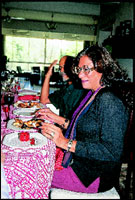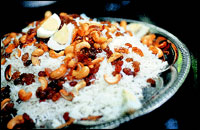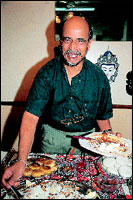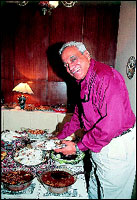


|
|
|
FIRST, a little secret. Jimi Kapur, wife of O&M chief Ranjan Kapur, is an East Indian. Her name used to be Lorraine Gomes and she lived in Colaba, Third Pasta Lane, and studied at Fort Convent; where a lot of East Indians used to live in and study at some 40 years ago in Bombay. Now the East Indians have moved out of Colaba and are staying in small villages in Bandra, Khar, Juhu and Amboli and Marol in Andheri, where they have cosy little cottages with a well in the backyard, pigs running around, and a mango tree under which some part of the wedding ceremonies are held. They also live in Khotache Wadi, Girgaum, and in the Mazagaon Village of Dockyard Road. Jimi now lives on Malabar Hill in a lovely little building on the slopes leading down to Napean Sea Road. Her house is modern, but it is also old-fashioned, and Jimi and Ranjan have filled it with all kind of memorabilia from their travels around the world and a nine-year stay in Singapore. There is much that is Christian about the place, but that is understandable, once an East Indian always an East Indian. Which brings us to what exactly this little community of Christian inhabitants from the North Konkan region is all about. They are not from the eastern states of India, from West Bengal and Orissa, but from Bassein, Salsette and northern Bombay.
That, and the fact that the East Indians have a cuisine that is Christian-like because of its dependence on beef, pork, chicken and duck, but is very different from the Christian food of Goa and Mangalore, is another characteristic of this minuscule community of Bombay. The cuisine is cooked on slow wooden or coal fires on traditional earthen and clay pots (chatties) and vessels. And the masalas that go into the cooking, but for the ubiquitous East Indian Bottle Masala, are all ground by hand on a stone at home. The old ladies of the house still talk of storing water in a handa, and salt or rice in a bandi; likewise, they use a thala for kneading dough, a karai for deep-frying, and a tope for keeping food. They use a kyota to chop coconuts and a pavda to dig the garden!
For the UpperCrust East Indian lunch, Jimi Kapur, who still maintains her touch with the old hand-me-down recipes, had prepared Pork Vindaloo with Sanas and Foogias; Prawn and White Pumpkin Lonvas; Potato Chops; Chicken Moile; and there was Bibique, Rose Cookies, Cordial, Bolins, Marzipan and Milk Cream for dessert. Sitting around her quaintly appointed dining table was a healthy representatives of East Indians from Bombay. Cardinal Simon Pimenta, is full costume coming straight from the Archbishop�s House in Colaba, PR veteran Roger Pereira, writer and activist Darryl D�Monte, businesswoman Heather Almedia, Ingrid Arthur, and Jimi herself. The food was served by Jimi�s efficiently-trained staff. The wine was poured and the Cardinal said, �The Italians say �attack� a meal! What do East Indians say?� But he didn�t have to bother, because the East Indians at the table were attacking the food already.
Bottle Masala The masala consists of 20 spices (or more!) in varying proportions. The main ingredients are dry red chillies and coriander seeds. The spices have to be dried in the sharp sun, that is why Bottle Masala is made before the monsoon. Each condiment is roasted on a slow fire and pounded in a wooden mortar with a wooden pestle. The pulverised spices are mixed by hand and tightly-packed in air-tight, dry bottles with a wooden spoon. The bottle is then sealed. If properly stored, this masala can remain for a long time. Bottle Masala differs in pungency, flavour and even colour depending on the ingredients used. The East Indians use it for everything. They swear that the cuisine does not taste the same without it! The Bottle Masala has travelled far and wide, East Indian emigrants take it with them to Canada and Australia, and there are some restaurants aborad, like Namita Panjabi�s Chutney Mary in London, that use it in their cooking.
|

Home Page
About the mag
Subscribe
Advertise
Contact Us
 Prawn Lonvas & Chicken Moile
Prawn Lonvas & Chicken Moile
 On the occasion of the golden jubilee of Queen Victoria the Christians of North Konkan adopted the name East Indians to make themselves distinct and separate from the immigrant Christians. The name may have something to do with the East India Company and the fact that medieval Europeans referred to the land in the east as India and used the term �East Indies�. The East Indians were converts and were the earliest Roman Catholic subjects of the British Crown when Bombay was ceded to the British in 1661. The East Indians are distinct in another sense too. You have to be a Christian to be an East Indian. Whereas Goans and Mangaloreans continue to be Goans and Mangaloreans even if they change their religion.
On the occasion of the golden jubilee of Queen Victoria the Christians of North Konkan adopted the name East Indians to make themselves distinct and separate from the immigrant Christians. The name may have something to do with the East India Company and the fact that medieval Europeans referred to the land in the east as India and used the term �East Indies�. The East Indians were converts and were the earliest Roman Catholic subjects of the British Crown when Bombay was ceded to the British in 1661. The East Indians are distinct in another sense too. You have to be a Christian to be an East Indian. Whereas Goans and Mangaloreans continue to be Goans and Mangaloreans even if they change their religion. The food has names like Beef Alimore, Chicken Guisad and Baffad, Duck Moile, Mince Frithad, Mutton Khudi, Pork Tamriad, Trotters Khudi, Fish Bamboca, Prawns Lonvas, and vegetables like Brinjal Brooth and Cauliflower Foogath. Plus, Wedding Rice and Foogias. And desserts, or sweets, like the Bibique, Bolins, Cordial, Do-Dol, and Thali Sweet. The names are what distinguish them from the other Catholic cuisines of Goa and Mangalore. And the Bottle Masala, of course. There is very limited vegetarian food in East Indian cuisine. And very little use of coconut. Goans and Mangaloreans use lots of coconut. They will also prefer to use every ingredient fresh and nothing is out of a freezer. The tastes differ, any East Indian will say. And cooking must be done on slow fires, never the pressure cooker.
The food has names like Beef Alimore, Chicken Guisad and Baffad, Duck Moile, Mince Frithad, Mutton Khudi, Pork Tamriad, Trotters Khudi, Fish Bamboca, Prawns Lonvas, and vegetables like Brinjal Brooth and Cauliflower Foogath. Plus, Wedding Rice and Foogias. And desserts, or sweets, like the Bibique, Bolins, Cordial, Do-Dol, and Thali Sweet. The names are what distinguish them from the other Catholic cuisines of Goa and Mangalore. And the Bottle Masala, of course. There is very limited vegetarian food in East Indian cuisine. And very little use of coconut. Goans and Mangaloreans use lots of coconut. They will also prefer to use every ingredient fresh and nothing is out of a freezer. The tastes differ, any East Indian will say. And cooking must be done on slow fires, never the pressure cooker. They talked of how during the Bandra Fair in September, East Indian cooking came into its own. And how duck breeding and piggeries was such a big business among the members of the community. For duck, or for a stuffed piggling, there were East Indian caterers who required short notice to produce any family�s needs. And they discussed Bombay Ducks and East Indian Pork Sarpatel which is unlike the Goan Pork Sorpotel, and made without dried pig blood, but with Bottle Masala, the pork pieces chopped small and fine. The Cardinal wanted to know why nobody served Khimad nowadays. Roger Pereira explained simply what was Khimad. �It�s grog!� And Darryl D�Monte assuring the table that he could produce it any day added, �Khimad is country liquor brewed with a cinnamon stick.� Cardinal Simon Pimenta, who raised the subject of Khimad, said, �In the olden days, East Indians also used to drink Khimad which was like toddy with cinnamon. It was a nice drink, served hot from a kettle. Now who will give me Khimad!�
They talked of how during the Bandra Fair in September, East Indian cooking came into its own. And how duck breeding and piggeries was such a big business among the members of the community. For duck, or for a stuffed piggling, there were East Indian caterers who required short notice to produce any family�s needs. And they discussed Bombay Ducks and East Indian Pork Sarpatel which is unlike the Goan Pork Sorpotel, and made without dried pig blood, but with Bottle Masala, the pork pieces chopped small and fine. The Cardinal wanted to know why nobody served Khimad nowadays. Roger Pereira explained simply what was Khimad. �It�s grog!� And Darryl D�Monte assuring the table that he could produce it any day added, �Khimad is country liquor brewed with a cinnamon stick.� Cardinal Simon Pimenta, who raised the subject of Khimad, said, �In the olden days, East Indians also used to drink Khimad which was like toddy with cinnamon. It was a nice drink, served hot from a kettle. Now who will give me Khimad!�